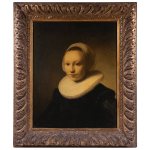Editor’s Note: This story originally appeared in On Balance, the ARTnews newsletter about the art market and beyond. Sign up here to receive it every Wednesday.
Given the art market’s well-documented “correction” this year and last, you might think the larger luxury market would be down as well. If so, you’d be very wrong.
A recent study analyzing global luxury spending found that while art sales only grew between 1 percent and 3 percent last year, the overall luxury sector grew between 8 percent and 10 percent. The total revenue figures, according to the study published in June by consulting firm Bain & Company and Italian luxury association Altagamma, estimated the global luxury market at approximately $1.66 trillion; fine art accounted for a mere $45 billion of that.
In surveying people in the trade and analyzing public sales data, Bain found that auctions experienced an estimated 20 percent drop in spending. (This tracks with information recently released by the major auction houses: Christie’s reported in July that auction sales were down 22 percent in the first half of 2024, compared to the second half of 2023, while Sotheby’s saw auction sales drop 25 percent over the same period.) Private dealers, on the other hand, saw modest growth, thanks, according to the report, to collectors seeking more in-person interactions post-Covid-19. The report attributed the lower auction figures to more cautious spending amid a slowly recovering US market, ongoing geopolitical conflicts, and “inconsistent performance” in Asia.
“The fine art market hasn’t been growing very dynamically in 2023 and, in the first quarter of 2024 … the auction market continued slowing down,” Joëlle de Montgolfier, coauthor of the report, told ARTnews. Executive vice-president for Bain’s Global Retail, Luxury and Consumer Products Practice, Montgolfier added that, among the trade’s participants “there’s a perception of shrinkage.”
Art also underperformed relative to other small luxury categories that continue to grow, like jewelry and collectibles.
A 2024 report published by UBS jointly with Art Basel estimates the $65 billion art market grew by only 1 percent since before the pandemic. That survey relies on self-reported revenue figures and does not publish metrics related to profit margins.
The macro uncertainties aren’t expected to materially affect the ultra-wealthy, at least according to a Deloitte report published in May surveying more than 300 family offices each overseeing an average of $2 billion in intergenerational assets. Some 70 percent of those surveyed said they expect to see that value grow this year.
The Bain study also touches on broader trends in luxury spending. While traditional luxury products like fine art experienced limited growth, experiential luxury, such as high-end travel, saw substantial gains. Consumers increasingly prefer experiences over physical objects, according to Montgolfier, with heritage brands shifting attention to an experiential sector that functions more like hospitality.
The art industry responded to this trend. Hauser & Wirth founders Manuela and Iwan Wirth opened the Fife Arms, an ornate hotel in the Scottish Highlands, as well as restaurants in St. Moritz, London, New York, and Los Angeles. Earlier this month, Sotheby’s announced a deal with Marriott’s Luxury Group, a subsidiary of the hotel chain, which will supply venues in different countries for the house to show its products.
George Hammer, global head of luxury marketing at Marriott International, told ARTnews that they’re trying to unlock a new tier of exclusivity. “We’re seeing a significant shift away from traditional, transactional luxury—people want more than surface-level beauty,” he said.
Major luxury brands like LVMH, Loewe, and Lanvin, meanwhile, have expanded into the art world, funding sculpture commissions and major art prizes and sponsoring exhibitions. (In 2014, LVMH opened a marquee art space, Fondation Louis Vuitton, and it also owns and operates several hotel brands, with a Louis Vuitton hotel set to open in Paris in 2026.)
Natasha Degen, a professor at the Fashion Institute of Technology in New York, sees the increase in the fashion labels moving between commercial and institutional spaces—ranging from hotels to museums to private foundations—as a way to hold their clientele’s attention for extended periods.
“It’s a strategy to keep visitors in the space longer, a 360-lifestyle brand deepening a consumer’s relationship with it,” she told ARTnews.
Auction houses, meanwhile, are increasingly relying on luxury categories besides art to drive revenue. Last year, jewelry, watches, memorabilia, and other luxury products generated almost a third of Sotheby’s $7.9 billion total revenue. At Christie’s, that figure was $2.1 billion. Josh Pullan, head of the global luxury division at Sotheby’s, told the New York Times in May that such auctions were “an unbelievable entry point for new clients,” with half the buyers and bidders being new to the house.
Adding to the slowdown overall is the difficulty luxury groups still face in appealing to high-end buyers when art acquisitions fall to the lowest rung of their fiscal priorities, Montgolfier said. According to Degen, the fraught political environment is discouraging aspirational spending, a big factor behind stalling revenues. “In a time of conflict, it’s seen as inappropriate or excessive,” she said.
This post was originally published on this site be sure to check out more of their content








